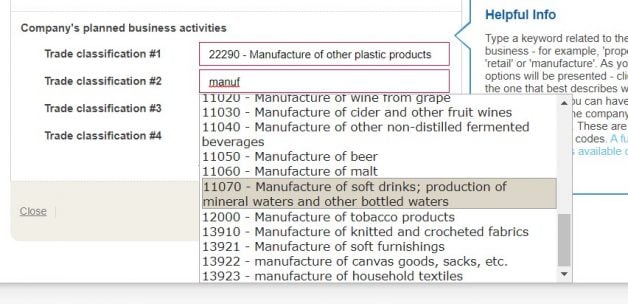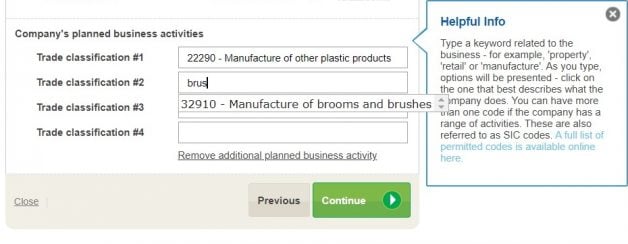When incorporating a company in the UK, you have to choose at least one SIC code, and sometimes as many as four. SIC codes form a classification system that tells Companies House what the company does. It is a structured system that promotes uniformity in recording companies’ main business activities. A SIC code consists of a numeric code attached to a description of the company’s main business activity in natural language. These can range from the mundane, e.g. 30190 ‘Manufacture of motorcycles’ to the more exotic, e.g. 01440 ‘Raising of camels and camelids’. This article covers all the basics about this classification system in five parts:
Need a new SIC code?
Inform Direct makes it simple to find your SIC Code or choose a new one.
Get started1 What is a SIC code?
A Standard Industrial Classification code or SIC code is a 5-digit code that classifies a business’s main area of economic activity and is used for sorting companies into categories. It must be chosen from an official list of SIC codes. The classification of each company is available for anyone to view on the public record.
Usage note: It is tempting to think that the C in SIC stands for Code. In this case the C is for Classification so it’s fine to say ‘SIC code’.
The list of SIC codes is grouped into categories: Section A (Agriculture. Forestry and Fishing), Section B (Mining and Quarrying), and so on, as far as Section U (Activities of extraterritorial organisations and bodies). Each category contains multiple business activities which are subdivisions of the main one, e.g. Section H (Transportation and storage) has subdivisions such as Freight rail transport, Taxi operation and so on. In theory, any business activity will fall somewhere within one of the subcategories on the SIC codes list.
2 How many SIC codes does my company need?
In most cases a company will be able to decide on the SIC code that most closely describes what they do, register the company as such, and move on with their lives. However, a company may choose up to four codes if their business is particularly complex or hard to categorise. Sometimes a combination of codes is the best way to describe a company’s area of activity.
3 When do I need a SIC code?
In brief, you need to choose a SIC code at the point of incorporation.
Unless the application includes at least one SIC code, Companies House will reject the formation request. For companies formed before 30 June 2016, there was no need to include a SIC code at the point of incorporation. For more on the 2016 changes please read this article: Changes to company incorporations from 30 June 2016
There’s no need to make an immediate submission to Companies House when the change occurs. It is sufficient to include the new SIC code in the next confirmation statement.
SIC code(s) only need to be included in a company’s annual confirmation statement if they have changed since the last confirmation statement or the incorporation of the company. This might occur, for instance, if the company expands or changes its operations during the year. It will perhaps be particularly common in the company’s first year, when the actual experience of trading might be different to the original intention.
There’s no need to make an immediate submission to Companies House when the change occurs. It is sufficient to include the new SIC code in the next confirmation statement.
Note: Limited liability partnerships (LLPs) are not required to provide a SIC code to Companies House. It will not be needed upon formation of the partnership or on an LLP’s confirmation statements.
4 What is my SIC code?
Existing companies will usually have notified a SIC code in a previous filing to Companies House. You can obtain full details about your company from Companies House via Inform Direct, including the SIC code. Obtaining this information using Inform Direct is straightforward and completely free – you can have all the information to hand in minutes.
If you’ve not previously submitted a SIC code to Companies House or if the existing one no longer represents what your company does, you’ll need a way to find the right one to use for your company.
This can be a challenge. You can’t just say, for example, ‘We make those brushy things that go on the end of your hoover’. You would have to find the most appropriate code on the list, which might be 22290 ‘Manufacture of other plastic products’, or arguably 32910 ‘Manufacture of brooms and brushes’.
Within Inform Direct, we’ve put together a handy keyword search tool for finding the best SIC code for your company. You can type in words that relate to what your company does and it will offer suggestions from the official SIC code list.
In many cases, there just won’t be one that’s absolutely spot on. Inform Direct users can experiment for free with keywords to find the code that most closely describes the activities of their company.
5 Where did UK SIC codes come from and what are they used for?
A system of codes was introduced in the USA in 1937. The UK SIC code system, originally introduced in 1948 and officially known as United Kingdom Standard Industrial Classification of Economic Activities, was then based on this. There have been quite a number of different lists of industry classifications in the UK, mainly to keep up to date with the changing structure of the UK economy, industry and employment. Since the original list, there have been revisions published in 1958, 1968, 1980, 1992, 1997, 2003, and 2007.
2007 SIC codes each have five digits where the 2003 industry codes each had just four. All companies are required to use the ‘new’ 2007 industry code list from 1 October 2011.
The most recent update made UK SIC codes consistent with the United Nations’ ISIC standard and the European Union’s NACE system, although the most noticeable difference for most people is the fact that the 2007 SIC codes each have five digits where the 2003 industry codes each had just four. All companies are required to use the ‘new’ 2007 industry code list from 1 October 2011. [2022 update: the 2007 list is still the most recent]
Alongside other government bodies, the Office for National Statistics gather and publish data based on the SIC classifications: as an example, it allows for comparison of earnings figures between different industries and occupations. The SIC codes of your company and others are publicly available, so can also be used for research purposes by any other third party.
… in our experience Companies House have never penalised a company for choosing a ‘wrong’ SIC code if it was picked in good faith.
Companies House uses a condensed version of the list of SIC codes from the Office of National Statistics (ONS). That list contains many more codes and gets much more specific, with classifications as narrow as 52720 ‘Repair of garden trimmers’ and 29530 ‘Cream separator for industrial use (manufacture)’.
At the time of writing there are 732 SIC codes on Companies House’s condensed list, if you include 99999 (Dormant company). Finding the right one for your business can be a puzzle, but in our experience Companies House have never penalised a company for choosing a ‘wrong’ SIC code if it was picked in good faith. And in any case, it can be changed in the next confirmation statement.
This article was originally published in 2013. We update this blog frequently for recency and comprehensiveness. The most recent revision to this article was in July 2022.
Inform Direct makes it easy to maintain registers, manage company records and submit statutory filings to Companies House at the touch of a button.



Thank you for this useful information!